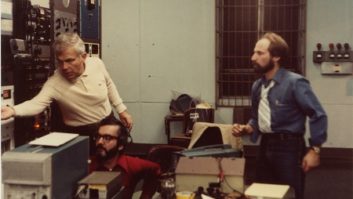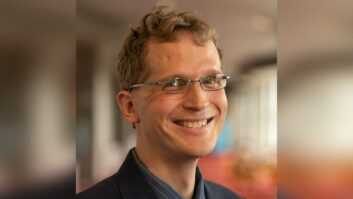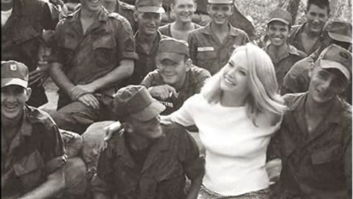
Leonard Kahn is in white at left, with his engineers Robert R. ‘Bob’ Gordon in red and Ira M. Salzman in blue. Herb Squire dates the photo to the early morning hours of Oct. 3, 1983. They were installing the AM stereo exciter at WQXR(AM) New York. The Westinghouse 50HG-2 transmitter went on the air in 1956. A Continental 317C-2 rig would arrive on site in 1983. WQXR Chief Engineer Zaven ‘Doc’ Masoomian took the photo. Squire became CE when Masoomian retired in 1986.
A Kahn Symmetra-peak brochure from the 1960s. Colleagues and friends of Leonard Kahn unanimously agree that the gifted engineer’s life would make for a remarkable storybook.
Kahn, who died in Florida in June at age 86, certainly lived a life worthy of documentation, they said.
The inventive Kahn, former chief executive officer of Kahn Communications, was described with words like determined, eccentric, brilliant, argumentative, unique and, in his later years, litigious. Colleagues said he was a man of many layers wrapped into one body of genius.
Kahn was well known for his Kahn AM stereo system and later the Compatible AM Digital system, known as CAM-D. Colleagues remembered his legal attempt to block Motorola from using its C-QUAM system in the United States in the 1980s — saying C-QUAM violated FCC emission bandwidth specifications — and his later bitter lawsuits against iBiquity Digital Corp.
Broadcast Devices Inc. President Bob Tarsio said, “Leonard was not crazy or eccentric, which I have seen written. He was a driven engineer only interested in what was right both in engineering, business and his personal dealings.”
Tarsio, who met Kahn in 1983, points to the 1960 edition of the NAB Engineering Handbook as evidence of the kind of engineer Kahn was.
In the handbook, continues Tarsio, “is Leonard’s paper on compatible single-sideband operation for AM broadcasting. You will find real explanations of system operation and most importantly the mathematics of how it all worked.
“Many so-called white papers that are written today are nothing more than sales pitches without science to back them up,” Tarsio said. “Verity in science and life — that was the kind of man Leonard Kahn was.”
RCA Labs
Kahn held many key patents in HF transmission and worked on shortwave and single-sideband transmission for RCA Labs early in his career. Tarsio considers Kahn to be one of the “legends of broadcasting” because of his contributions, including his work with Envelope Elimination and Restoration, or EER, “which eliminated and then restored the carrier in a linear modulation system that allowed for the use of a Class C amplifier to be used in a more or less linear mode, which saved power and reduced electrical costs.
“He’s right there with Armstrong, de Forest, Hertz and Maxwell,” Tarsio said.
EER, sometimes referred to as the Kahn Method, is used in many digital transmission schemes worldwide, Tarsio added.
“Leonard’s impact was that he was one of the last broadcast innovators who believed that technology for technology’s sake was not enough. If you developed a system it had to have efficacy and provide a true improvement and it had to be the best solution.”
Kahn Research Laboratories proposed the concept of AM stereo in 1958 and 1959, according to earlier Radio World coverage. About that same time, Philco Corp. and Radio Corporation of America proposed competing systems. However, the FCC stalled on a rulemaking procedure, citing a lack of interest in AM stereo at the time.
By the 1980s, five companies, including Kahn Communications, had developed AM stereo systems. The others were Harris, Motorola, Magnavox and Belar Electronics.
The FCC originally picked the Magnavox AM stereo system as the U.S. standard in April 1980, based on a complicated matrix of performance attributes to which the agency assigned scores, said an observer familiar with the selection process. Magnavox had the highest total of the five AM systems considered. However, many in the industry protested, calling the commission’s research and decision-making process incomplete and partially flawed. So the agency backtracked and decided to let market forces determine the winner.
However, by 1993, it became clear there needed to be one AM stereo standard in the United States. Other countries began adopting Motorola’s C-QUAM, and that’s what the FCC chose. At the time, of the 660 radio stations using AM stereo, 591 were using Motorola’s system. Fewer than 20 were using Kahn’s system, according to the agency.
AM stereo ultimately did not flourish in the marketplace; over time, for many in radio, the experience would come to be seen as a poorly handled technical rollout and regulatory debacle.
Kahn also created Symmetra-peak while working at RCA. This was a passive device that equalized the positive and negative audio peaks being sent to a station’s transmitter and helped increase modulation density before the days of sophisticated multiband audio processing systems, according to long-time acquaintance Herb Squire, vice president of engineering for DSI RF Systems Inc.
Another observer called Symmetra-peak “Kahn’s single biggest contribution to broadcasting. The technology later went on to become standard in nearly every name brand audio processor you can think of.”
Squire said, “Symmetra-peak restored the symmetry and balance between positive and negative peaks of voice signals, which tend to be asymmetric. It made the stations louder.”
According to Kahn’s marketing materials at the time, the Symmetra-peak “redistributed unequal positive and negative peaks symmetrically about the zero axis.”
Powerside, CAM-D
Squire, who knew Kahn since 1969, testified as an expert witness on behalf of Kahn in some of the lawsuits. Squire worked with Kahn’s AM stereo system at WQXR(AM) and WQEW(AM) in New York.
“I was in regular contact with Leonard [during that time]. He and his guys would come out and tweak the system. WNBC(AM) also had his AM stereo system. He was right there with the technology. He lived his work. That was his life,” Squire said.
Squire and other observers believe Kahn’s development of his AM stereo system, which dates to the early 1960s, was complicated at first by the FCC’s reluctance to adopt a standard while hoping the marketplace would settle the issue. Kahn used independently modulated upper- and lower-level sidebands for the Kahn-Hazeltine AM stereo system, used at one time by WLS(AM) Chicago.
Kahn’s Powerside, a system to minimize distortion of selective fading such as skip conditions, eventually led to CAM-D, which was an in-band, on-channel technology for AM digital radio, several observers noted. However, his legal dealings against iBiquity and Clear Channel — chronicled in Radio World at the time — had him mired in court for years beginning in 2006.
Kahn touted CAM-D as a major improvement over iBiquity’s digital AM system. Kahn claimed his system did not increase adjacent or co-channel interference, Kahn told Radio World then.
“I think he was extremely frustrated by that time, but he was so dedicated to his work,” Squire said. “His years in the business overlapped so many generations. He knew Major Armstrong, of course,” he continued, referring to FM pioneer Edwin H. Armstrong, “and when you look at those two lives, there were a lot of similarities at the end, with the lawsuits.”
Kahn would often send Squire cassette tapes of various recordings to get his opinion on sound quality. He was notorious for balking over any constructive criticism of his products. Rather “thin-skinned” is how one former colleague recalled Kahn.
Kahn’s opinions and comments were published in Radio World, but he was critical of its coverage. During industry debate over AM IBOC operation, he wrote on his website that columns by “masked engineer” Guy Wire had taken his statements out of context. He called this “yet another example of Radio World type reporting and the reason we never send RW our press releases or authorize my associates at KCI to grant interviews to Radio World reporters.” He did talk to Radio World reporters at other times.
But in a letter to its then-parent IMAS Publishing, he stated that Radio World had staged an interview with a radio corporate director of engineering and displayed a “willingness to participate in a plan to deceive the broadcasters and the public they serve” regarding engineering characteristics of the IBOC system.
Robert Meuser, chief technical officer for design engineering company Engineaux, described Kahn as “a very complex figure. You either loved him or hated him. He could push very hard, but single-sideband technology was truly dear to his heart.”
Meuser read Kahn’s technical writings before meeting him in the 1970s; he described the period of the AM stereo wars in the 1980s as the time “when I first saw the cantankerous side of Kahn. You were either with him or against him. He was kind and generous to those who was on his side. There was no middle ground.
“As brilliant as he was, he really liked to keep the technology to himself. His AM stereo equipment (STR-77 and STR-84) was very difficult to adjust. We told him it needed to be more solid mechanically. This annoyed Leonard, very much so,” Meuser said. “I fell out of his favor around that time. But that is the way he was.”
Still, Meuser acknowledged Kahn’s work with the EER concept as “incredibly important” in the history of wireless communications.
Meuser said so many things in communications can be attributed to Kahn, from low-power digital devices to the way that HD Radio in the United States and Digital Radio Mondiale technology in Europe is used on AM.
“They all basically use the EER concept. When you look at European technical papers they actually refer to it as the Kahn Method,” Meuser said. “So deploying that and getting people to recognize EER is probably his biggest single contribution.”
Kahn’s wife, Ruth, preceded him in death in 2004, according to various reports. The couple had no children.
Comment on this or any story. Write to [email protected].











